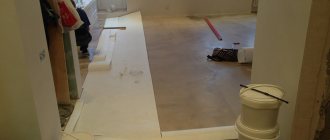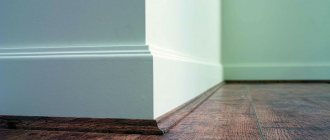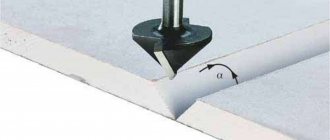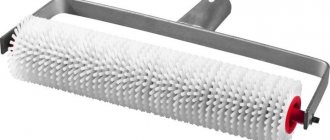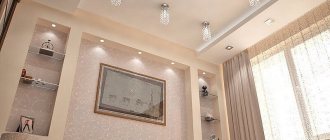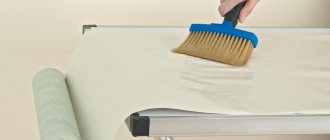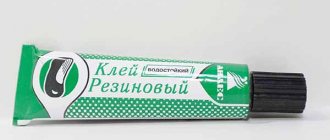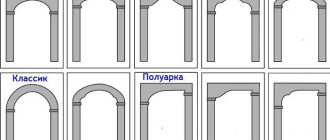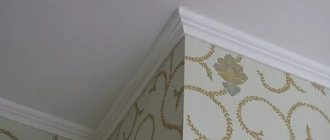Criteria for choosing varnish for parquet floors
The paint and varnish composition is selected individually depending on the shade and type of wood from which the parquet floor is laid.
For example, it is not recommended to use dark varnish for light dies. The color of the wood and paintwork materials must match each other. You should choose a varnish for parquet depending on the following criteria:
- The level of load on the floor covering and the intensity of people moving around the room.
- The chemical composition of the paintwork material and the primer for it (they must be compatible and have components on the same basis).
- The absence or presence of plans to give the finish various effects such as matte, gloss, etc.
- A one-component or two-component mixture is selected (the first is easier to work with, but the second provides a more durable protective layer).
The more people walk around the room, the more often you will have to clean it and wash the floor. But even more durable must be the paint coating on parquet flooring, otherwise it will quickly wear off. Therefore, it is necessary to take the most durable compounds for the office or corridor in the cottage. And if the project of a small house for a family of 2-4 people is being implemented, then the parquet in it can be covered with less wear-resistant analogues that cost several times less.
Types of varnish for parquet
The best varnish for parquet: features, varieties and selection rules
We offer our customers the best parquet varnish from trusted manufacturers. We understand how important the quality of such a product is to completing the flooring process. That is why we cooperate only with those manufacturers and suppliers in whom we are personally confident. In the catalog you can buy varnish for parquet in Moscow or any other city in Russia. This is very convenient, because a large selection and quick search for the right option allows you to save a lot of time!
Water-based varnish for parquet
A budget-friendly and easy-to-use type is a water-based varnish composition for parquet flooring. It consists of emulsifiers, water and solvents.
The solvent concentration is 5-15%, but there are varnishes that do not contain this component.
The advantages of water-based varnish compositions are the absence of a pungent odor, an increased coefficient of fire resistance, and high protective properties against water. However, one should not forget about the disadvantages of such varnish compositions.
Water-based varnish for parquet
Water-based varnishes are often used, but they should not be used, there is parquet made of pine, beech, hornbeam
Initially, the disadvantages include low wear resistance and a short service life of the coating. Such a varnish composition can only be applied if you have special tools in your arsenal. Unfortunately, not every parquet can be coated with such varnish. For example, beech, hornbeam, and pine do not tolerate treatment with water-based varnish.
Does the choice of varnish depend on the type of wood?
Almost any varnish performs its functions well on ordinary parquet flooring made of oak, beech, maple, etc. If the parquet flooring is made of cork, oily, resin-containing and exotic woods, you will have to carefully select the varnish, taking into account all the features of the material.
Often the types of wood that can be varnished are marked on the packaging material. If such recommendations are not indicated, it turns out that it is permissible to apply varnish only to a standard parquet flooring made of undemanding material.
Usually the instructions for using parquet varnish indicate what type of wood it can be combined with
Waterless polyurethane varnishes
Such compositions dry much faster than water-based varnishes. As soon as the solvent evaporates, the composition will harden.
Polyurethane varnish can be one-component (PUR) or two-component (DD). The varnish base can be acrylic, urethane or solvent. In most cases, various aromatic impurities are added to the compositions to neutralize the pungent chemical odor. Polyurethane varnishes can be called universal, because they can be used both in rooms with low and high traffic. The coating is durable and wear-resistant. In addition to this, there are other advantages:
- UV resistance;
- Heat resistance;
- Elasticity;
- Resistant to moisture;
- Not demanding on the room microclimate.
The disadvantages include:
- The ability to glue dies when they get into the gaps between them;
- Demanding quality of parquet drying. Wood moisture content should not exceed 8%, otherwise the coating will bubble;
- If water gets on the surface of the varnish before it is completely dry, it may cause foam or bubbles to form.
We can say that polyurethane varnish is the best choice for covering parquet in any room.
Drying time varies depending on whether it is hot or cold
Above: We conducted a series of tests on a cold autumn day. First, various finishing compounds were applied to scrap oak boards in a warm workshop, and then in a cold garage. Eventually all the samples dried, but as the temperature dropped, drying took much longer. For example, it took three and a half times longer to dry oil-based polyurethane in a cold garage at 5°C than in a warm workshop at 21°C. The fastest drying coatings in both cases were shellac and nitro varnish in an aerosol can.
For the “how long it dries” test we used:
| Shellac | Nitrolac | Water based polyurethane | Oil varnish | Water based polyurethane | Nitrolac | Oil-based polyurethane |
| varnish | aerosol | |||||
| aerosol | brush application | |||||
Bottom: To prevent dust particles from settling on wet and sticky surfaces, do not direct the air flow directly at the surface, but install a pair of small fans on either side of the product, blowing in opposite directions.
In preparing the article, materials from a very interesting publication for woodworkers and cabinetmakers, WoodMaster, were used
TOOLS FOR CRAFTSMAN AND CRAFTSMAN, AND HOUSEHOLD GOODS VERY CHEAP. FREE SHIPPING. THERE ARE REVIEWS.
Below are other entries on the topic “How to do it yourself for a homeowner!”
- How you can measure the required amount of fertilizer using improvised means. Memo for the gardener - mass...
- Pruning shrubs - table-memo for the gardener FEATURES OF Pruning SHRUBS - AGRONOMIST...
- Do-it-yourself solutions for processing and spraying seedlings How to prepare solutions for seedlings...
- Do-it-yourself bench for a bath - photo Bench for a bath - how...
- Conventional designations: floor coverings, laminate, ceramic tiles Laminate and tiles are symbolic...
- Fertilizers for the garden and vegetable garden - schedule and MOST VALUABLE practical experience MY EXPERIENCE, REVIEWS AND FEEDINGS...
- DIY barn - from foundation to roof (+ drawings) How to build an inexpensive frame barn
Foundation…Subscribe to updates in our groups and share.
Let's be friends!
Acrylic varnish for parquet
The peculiarity of this varnish composition is that it consists of a dispersion of plastic mass and acrylic that can be completely dissolved in a water base.
As a result of such composite combinations, the varnish, after drying, creates protection in the form of a film with exceptional quality characteristics that can protect the coating from mechanical loads and aggressiveness of the external environment.
The varnish composition for processing parquet flooring can consist of one or two components. Either acrylic or its mixture with other components (for example, polyurethane) can act as a binding component.
Acrylic varnish for parquet
Acrylic varnish for parquet emphasizes the structure of wood and makes the floor covering more resistant to water and mechanical stress
The irrefutable advantages of acrylic-based varnishes include its resistance to temperature changes, high heat conductivity and resistance to moisture, mechanical stress, wear, protective properties against UV radiation, high strength characteristics, environmental friendliness and a weak, mild odor. There are practically no downsides. The use of acrylic-based varnish is acceptable both indoors and outside the walls. The varnish perfectly performs the role of an antiseptic, thanks to this you don’t have to worry about damage to the coating by harmful microorganisms and further destruction.
What can I do to make parquet floor varnish dry faster?
After scraping (sanding) the parquet, in case of its restoration, the floor should be covered with several layers of varnish. But a situation may arise that the second (third) layer of varnish will take a painfully long time to dry. Let's talk about how to avoid this in advance, and what to do to ensure that your parquet floor varnish dries as quickly as possible.
So, just the other day, I was faced with the problem of long-drying varnish for a parquet floor. We restored the parquet, then covered it with the first layer of varnish, which absorbed very well into the wood and dried in a few days. Back then I didn’t know how long it took for parquet varnish to dry, so it seemed to me that two days was a very long time. But back then I had no idea what awaited me ahead! After the first coat of varnish had dried, I applied the second coat and left the apartment for four days. Imagine my surprise when I saw that the varnish had not dried in many places! It stuck to the shoes, as evidenced by the unpleasant “tearing” sound of the sole being torn off the floor.
Alkyd varnishes
Or oil-based varnishes. The main component is alkyd resins, which are obtained from natural materials.
These can be wood, linseed and other oils. In addition, the composition includes white spirit, the concentration of which can be high or low. The latter option is more preferable, as it is less toxic. Alkyd varnishes have the following advantages:
- They do not have an adhesive effect and do not flow into the joints of the parquet, which completely eliminates the possibility of squeaks;
- The composition has high penetrating properties and allows you to change the shade of wood and make it more saturated;
- Not sensitive to changes in temperature and humidity in the room.
Now about the disadvantages:
- Due to its ability to penetrate deeply into the wood structure, the color of the coating can subsequently be changed only after sanding the surface. In this case, you will have to remove a layer of several millimeters, which will lead to thinning of the dies, and therefore to a decrease in the technical characteristics of the parquet;
- The drying process of alkyd varnish must occur under strict adherence to the recommended temperature and humidity level, otherwise the coating may become wrinkled;
- It often takes at least a day for the composition to dry completely;
- The wear resistance of the coating is the lowest compared to other compositions, so alkyd varnishes are most often used not for parquet, but for furniture.
Parquet varnish: types and applications
Parquet varnish is a product that will extend the life of the flooring in your home and will highlight the elegant pattern of natural wood. Parquet varnish will solve several problems at once:
- protect the parquet board from mechanical damage and chemical exposure;
- ensure thermal and moisture resistance of the floor covering;
- prevent harmful effects of ultraviolet radiation.
Types of parquet varnishes
The components of the composition determine the properties of the product, the saturation of gloss, shade, and also ensure safety of operation. Based on their chemical composition, the following parquet varnishes are distinguished:
- primer - used as a base before applying the main varnish coating. Its use allows you to achieve the most even color of the finishing layer, increases the degree of its adhesion to the parquet board;
- water-soluble – it is environmentally friendly, has high adhesive ability, and does not have a pronounced odor even during application;
- polyurethane - optimal for rooms where there is a large flow of people, it is strong, elastic, durable;
- alkyd - will highlight the natural beauty of wood better than others, since it contains natural oils. It is resistant to heat and moisture and is not susceptible to mechanical stress.
In the Leroy Merlin online catalog you can buy varnishes for parquet boards by filling out an application on the website or offline - in hypermarkets in Moscow, Moscow Region and other Russian cities. The price depends on the chemical composition, packaging volume, and manufacturer. You can order an additional online tinting service with computer control of the colorant dosage to get the exact tone.
Instead of an epilogue
Today, choosing a varnish coating for parquet is not difficult. Both online stores and retail outlets offer a wide range of options to suit every taste and budget. Prices for this material vary very little from store to store, the difference can reach a maximum of 50-100 rubles. The main difficulty is the question of finding the required form of packaging - most stores try to sell varnishes in containers with overall volumes, but what to do if the buyer only needs a small amount for renewing? That’s why, before visiting a store, you need to study the information from its official website on the Internet and find out in what container the desired varnish is sold.
Among the popular manufacturers of these mixtures, there have been no significant changes over the past 20 years - Western brands are leading almost everywhere, and the domestic manufacturer has occupied a niche slightly below average.
When talking about buying for future use, preference should be given to samples with a long shelf life and universal scope of application.
Belinka quick-drying water-soluble parquet varnishes
Quick-drying water-soluble parquet varnishes dry very quickly due to their composition. Water first evaporates from the substance, and the film-forming element constantly increases its share in the solution. Next, drops of the binder evaporate - the varnish hardens completely. Belinka Parquetin water-based parquet varnish is a quick-drying material that allows repeated coats to be applied at intervals of 4-6 hours, and finally dries after 12 hours. It is recommended to bring in furniture, carpets or appliances after 7 days. Two-component parquet varnish Belinka 2K contains polyurethane resins, so it dries a little longer - about 24 hours. It is recommended to bring in furniture, carpets or appliances after 8 days. Primer for water-based parquet varnish Belinka, which should be used to pre-treat the surface, dries within 4 hours after application.
Let's dwell on the microclimatic conditions that affect how long it takes parquet varnish to dry. Firstly, it's temperature. It should be +18-+22°C. If the temperature is too low, the varnish will take a very long time to harden, and if the temperature is too high, cracks may occur and cause faster wear. Secondly, some materials absolutely cannot tolerate high humidity, so make sure that it does not exceed 50%. Thirdly, during drying it is better to keep the windows closed so that dust cannot enter the room and then settle on the freshly painted surface. Exposure to direct sunlight also leads to an increase in temperature, then to the appearance of microcracks.
Quick-drying varnish: what is on the market?
If you are not financially constrained, you need to know the subject of your future purchase. A lot of chemical concerns sell this product. A certified, genuine product is sold in large retail chains; any serious company has its own representative office. All the necessary information is on the label. Fast-drying, effective varnishes are:
- SADOLIN CELCO PROF CLASS. The product is from Sweden and meets all European safety requirements. Its hardening occurs under the influence of acid. Not prone to scratches, withstands sharp shoes well. Suitable for many types of wood.
- Quick Dry Polyurethane Floor Varnish Gloss. English product, acrylic-polyurethane varnish for floors and parquet. Supplied in 2.5 and 5 liter cans. Has the highest consumer ratings. The varnish is excellent for cork floors, environmentally friendly, and forms a strong surface.
- Panel varnish Irkom IP-11. Produced in Ukraine, sold in 5 liter cans. Very convenient for multi-layer application: drying time is just over 1 hour. This solution is white, after completion of work it forms a moisture-resistant film and does not change the tone of the wood.
Complete solution
An experienced painter uses all the possibilities that will speed up the process and bring maximum comfort. It is common to combine several methods.
Heat
Everyone knows physics: the higher the temperature, the faster evaporation occurs. It is foolish to work in cold, damp weather. If you work in winter, you can use a heat fan. And the room must be warmed up well before the operation.
Ventilation
Intense air movement always speeds up drying. This is perfectly evident after a simple wash: clothes will dry faster outside than indoors. The painter needs to create a draft, open all the windows and doors: things will be much more fun. A household fan is always useful, maybe two or three! Sometimes developers ask the question: “Can I dry the varnish with a hairdryer?” Yes! If you have the time and energy, keep the gadget near the surface being treated.
Thin layers
Any varnish without drying will harden faster if it is applied in a thin layer. This will delay the work a little, but the end result is that the surface will be suitable for use sooner.
Quick-drying floor paint and its features
Painting a floor is a long and rather labor-intensive process. Moreover, ordinary paint and varnish coatings have such a poisonous and disgusting odor that it is simply impossible to be in a room with a freshly painted floor. However, you can update your interior using innovative paint and avoid all these troubles. Modern quick-drying paint dries in a matter of hours and has no odor. Next we will look at its features and methods of application. Quick-drying, odorless floor paint has appeared on the market for a relatively long time, but not everyone knows about its existence and how to use it correctly. It must be said that with its appearance it made a small revolution in this area of building materials.
Moreover, the product is intended specifically for those people who cannot leave their living space during repairs.
Each of us knows how long regular floor paint takes to dry, and sometimes this discourages us from doing repairs. Fast-drying paint takes several hours to dry completely.
But, besides this, it has a number of other advantages:
- Does not have a pronounced chemical “aroma”;
- When working, you do not have to wear a respirator or mask;
- Has an anti-slip effect;
- The product is environmentally friendly and not harmful to human health;
- Relatively low price for the product;
- Does not fade or fade in the sun;
- There is no need to leave the room after painting the floors.
Types of quick-drying floor paint
First of all, quick-drying floor paints are divided according to their composition, they are:
- Acrylic,
- Polyurethane.
It must be said that there are other types of quick-drying paints, but they are either not suitable for painting floors or have a strong odor. Acrylic The binder in these paints is acrylic resins, which form a hard film after the solvent evaporates. Rapid drying is achieved due to the oxidation of alkyd resins in the open air.
Such products have many advantages:
- They can be used on all surfaces;
- Easy to use;
- Due to fast drying, the second coat can be applied four hours after the first.
- Easily washed off from instruments.
As a result, paintwork based on acrylic resins are the most popular. Polyurethane
Quick-drying polyurethane paints provide coatings with a lasting shine. These are also quick-drying paintwork coatings that are used to protect products that are subject to wear and friction, including floors. Polyurethane paintwork can give the surface the texture of crushed silk.
It should also be noted that they can be used for objects that are exposed to weather conditions, for example, for floors on the veranda. Otherwise, polyurethane coatings are similar to acrylic floor paints.
Note! Quick-drying paint is available separately for concrete and wood surfaces, so when choosing, you should consider what type of floors need to be painted.
How to paint floors with quick-drying paint
Applying quick-drying paint to your floors with your own hands is not difficult. When working with acrylic paints, it is best to use a wide, short-haired roller. They allow you to apply a layer of paintwork evenly and quickly.
Advice! To make it more convenient to work with the roller, you should put a long handle on it.
To paint corners and hard-to-reach places, you will need to use a small narrow brush.
Painting a concrete floor
You can paint a concrete floor when the surface temperature is not lower than 5 degrees Celsius, and the air temperature in the room should not fall below 10 degrees. Air humidity should be no more than 80 percent.
The procedure can be performed on fresh or wet concrete, but not earlier than five days after it is poured. Strokes should be applied in different directions, after which the paintwork is rubbed over the surface. Before applying the second layer, you need to make sure that the previous one has dried. Advice! The layers of paint should not be thick, as thin layers not only dry faster, but also look better.
How quickly the floor dries depends on many factors, such as the moisture content of the concrete, air humidity and temperature, etc. Therefore, do not rush to use the surface as quickly as possible so that it has time to completely dry and acquire the proper wear resistance. Painting wooden floors
Painting wooden floors is a little more difficult due to the unevenness of the surface. Therefore, a number of operations must first be performed. Instructions for performing this work are as follows:
- First of all, the floor needs to be oiled.
- Then the surface must be treated with a primer.
- After the primer has dried, if unevenness is noticeable on the floor, they should be filled with oil putty.
- Then the putty should be sanded, putty again and sanded with fine-grained sandpaper.
- Putty areas must also be treated with a primer.
- After this, you can proceed directly to painting. The procedure is practically no different from the method described above. In the same way, you should use a roller and brush and apply thin layers of paint to the surface.
- If necessary, the surface should be coated with a second layer of paintwork after the previous one has hardened.
Quick-drying paint allows you not only to update the appearance of the floor, but also is a reliable protective layer that can withstand even quite extreme operating conditions.

